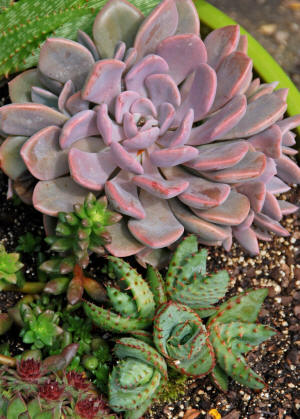|
 Houseplants
101 Houseplants
101
By Melinda Myers
 Send a link to a friend
Send a link to a friend
[January 22, 2019]
Lift
your spirits and improve your indoor environment by taking part in
the indoor gardening movement. An apartment or home filled with
tropical, succulent and flowering plants can provide beauty, extend
your garden season, improve air quality and create a peaceful
environment to de-stress.
|
|
 Though some may find indoor gardening a bit
intimidating, donít let past failures or the thought of tending
living greenery stop you from enjoying the many benefits. Knowing
some basics in care and making needed adjustments to the growing
environment can turn past failures into success. Though some may find indoor gardening a bit
intimidating, donít let past failures or the thought of tending
living greenery stop you from enjoying the many benefits. Knowing
some basics in care and making needed adjustments to the growing
environment can turn past failures into success.
Water, humidity and light are key to growing healthy plants. When
you match these to a plantís needs and the growing media, youíre
sure to experience success.
Use a container with drainage holes to avoid overwatering that can
lead to root rot and plant death. It should be no more than an inch
or two larger in diameter than the plantís root ball. Growing in a
larger pot results in the soil staying too wet, increasing the
chance of root rot.

Select a quality potting mix that holds moisture but drains well.
Cacti and succulents prefer a fast-draining mix while tropicals and
African violets prefer a mix that stays moist, not soggy, yet drains
well.
Set your plant in a location thatís free from drafts of hot and cold
air, but in the preferred light conditions. An east- or west-facing
window usually provides adequate light for most plants. Keep cacti,
succulents and other plants requiring high light within two feet of
an east- or west-facing window. Pothos, philodendron, Chinese
evergreens and those that tolerate low light can be placed near a
north-facing window or up to six feet back or off to the side of an
east- or west-facing window. Shears, awnings and trees can impact
the light reaching your plants. Adjust their location as needed.
Always water thoroughly and pour off the excess water
that collects in the saucer. Allow the top few inches of soil to dry
before watering drought tolerant plants like cactus. Water tropical
and flowering plants that prefer moist conditions when the top few
inches of soil are barely moist, like a sponge that has been wrung
out.
[to top of second column] |

Reduce maintenance and improve plant health with
gravel trays. Fill a tray or saucer with pebbles. Allow excess water
to collect in the tray. The pebbles keep the pot elevated above the
water to avoid root rot. As the water evaporates it increases the
humidity around the plant.
When pest problems occur, consider an organic approach safe for
people, pets and plants. Manage fungus gnats, those tiny fruit fly
like insects found flitting around the house, with a naturally
occurring bacteria, Bacillus thuringiensis israelensis, found in
Summit Mosquito Bits (SummitResponsibleSolutions.com). Just sprinkle
on the soil surface and repeat as needed until these pests
disappear.
Mites, aphids, scale and mealybugs can be controlled with an organic
horticulture oil like Summit Year-Round Spray Oil. This product
coats the pests and kills all stages from egg to adult. Repeat as
needed to control any that were missed. Once the pests are managed,
check the growing conditions and make needed adjustments to the
growing environment.
The more plants you grow, the easier it becomes and soon enough you
may find yourself immersed in a tropical or desert paradise inside
the comfort of your own home.
[Photo credit: Melinda Myers, LLC]
Melinda Myers has written more than 20 gardening books, including
Small Space Gardening. She hosts The Great Courses ďHow to Grow
AnythingĒ DVD series and the nationally syndicated Melindaís Garden
Moment TV & radio program. Myers is a columnist and contributing
editor for Birds & Blooms magazine and was commissioned by Summit
for her expertise to write this article. Myersís web site is
www.melindamyers.com.
 |